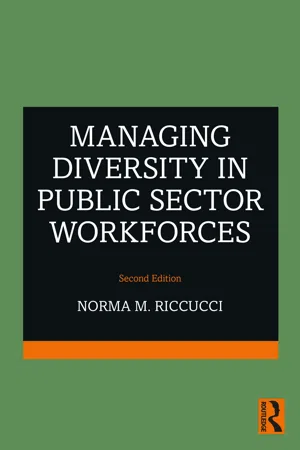
- 208 pages
- English
- ePUB (mobile friendly)
- Available on iOS & Android
Managing Diversity In Public Sector Workforces
About this book
Public and private sector workforces in the U.S. look very different today than they did even 25 years ago.
The changes are having a significant effect on how organizations manage their workforces. The old styles of managing heterogeneous workforces are proving to be ineffectual, and so management strategies aimed at embracing diversity and inclusion are essential. These strategies can have positive implications for worker satisfaction, morale and – ultimately – the delivery of public services to the American people.
Managing Diversity in Public Sector Workforces, Second Edition examines demographic changes to the U.S. labor force and workplace and the ways in which government employers are managing the diverse populations that now fill public sector jobs. Addressing specific management strategies and initiatives relied on by public sector employers, as well as the implications of effectively managing variegated workforces for the overall governance of American society, this book demonstrates the importance of ensuring that programs to promote inclusiveness and diversity that appear on paper are carried through to practice through implementation. The book begins with a review of equal employment opportunity and affirmative action and the extent to which EEO and AA are still relied upon in the workplace. It then examines law and other public policy issues surrounding EEO, AA and diversity management. The remainder of the book focuses on the core of managing diversity in the public sector, exploring the initiatives, strategies, and programs that government employers either do or might rely on to ensure that the demographic mosaic embodied by their workforces is prepared to meet the needs and interests of the American citizenry of the 21st century. Data are provided on the demographics of the federal, state and local government workforces. Separate chapters address each of the following aspects of diversity: race, ethnicity, gender, LGBTQ employment, physical ability, and the intersection of these constructs.
Managing Diversity in Public Sector Workforces, Second Edition will be of interest to students of public administration and public personnel management, and it is essential reading for all those involved in managing public organizations.
Frequently asked questions
- Essential is ideal for learners and professionals who enjoy exploring a wide range of subjects. Access the Essential Library with 800,000+ trusted titles and best-sellers across business, personal growth, and the humanities. Includes unlimited reading time and Standard Read Aloud voice.
- Complete: Perfect for advanced learners and researchers needing full, unrestricted access. Unlock 1.4M+ books across hundreds of subjects, including academic and specialized titles. The Complete Plan also includes advanced features like Premium Read Aloud and Research Assistant.
Please note we cannot support devices running on iOS 13 and Android 7 or earlier. Learn more about using the app.
Information
Chapter 1
Diversity Qua Diversity
EEO | Affirmative Action | Managing Diversity |
|---|---|---|
Qualitative/Quantitative | Qualitative/Quantitative | Behavioral |
Emphasis is on preventing or ending discrimination | Emphasis is on redressing past discrimination and achieving diverse, representative workforces | Emphasis is on building specific skills and creating a productive work environment with the organization’s human resources |
Legally driven | Managerially and legally driven | Strategically driven |
Mandated by federal law | Involves voluntarily developed goals as well as court-ordered programs. Common law has defined its legality and constitutionality | Behaviors and policies are seen as contributing to organizational goals and objectives such as productivity |
Fairness | Remedial and compensatory | Pragmatic |
Seeks to end discrimination and create equal opportunities | Specific voluntarily developed goals as well as court-ordered programs | The organization benefits in terms of morale and increases in productivity |
Access model | Assimilation model | Synergy model |
Model assumes that protected-class persons will be able to access organizations | Model assumes that persons and groups brought into the system will adapt to existing organizational norms. Can result in “sink or swim” atmosphere/environment | Model seeks to change organizational culture to accommodate diverse groups Assumes people will develop new ways of working together in a multicultural environment |
Level playing field | Opens doors | Opens the system |
Seeks to ensure equal opportunity and access | Seeks to affect hiring and promotion decisions in organizations | Seeks to affect managerial practices and policies |
The Demographics of the Workplace
2000 | 2050 | |
|---|---|---|
Men | 75,257 | 100,280 |
53.4% | 52.3% | |
Women | 65,616 | 91,545 |
46.6% | 47.7% | |
White | 117,574 | 143,770 |
83.5% | 74.9% | |
Black | 16,603 | 27,094 |
11.8% | 14.1% | |
Latinx | 15,368 | 45,426 |
10.9% | 23.7% | |
Asian | 6,687 | 20,960 |
4.7% | 10.9% |
Table of contents
- Cover
- Half Title
- Title Page
- Copyright Page
- Dedication
- Table of Contents
- Figures and Tables
- Preface
- Acknowledgements
- 1 Introduction: Workforce Diversity and the 21st Century
- 2 Law and Public Policy: EEO, Affirmative Action and Diversity Management
- 3 The Significance of Diversity and Social Equity
- 4 Race and Diversity Management
- 5 Managing Diversity around Ethnicity
- 6 Diversity Management and Women in Public Sector Workforces
- 7 Diversity and LGBTQIA
- 8 Disability and Diversity in the Workplace
- 9 Diversity, Diversity Management and Intersectionality
- 10 Public Sector Organizations Positioning for the Future
- Index